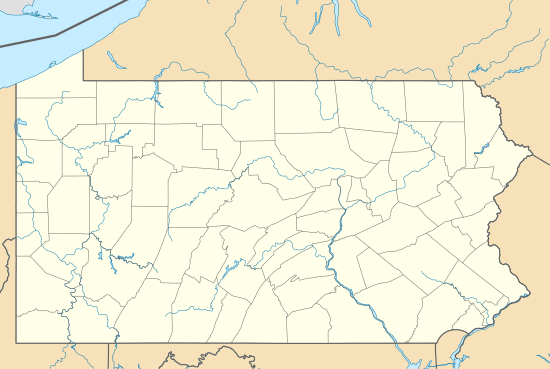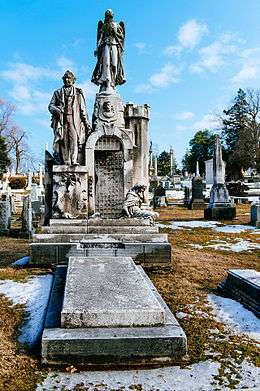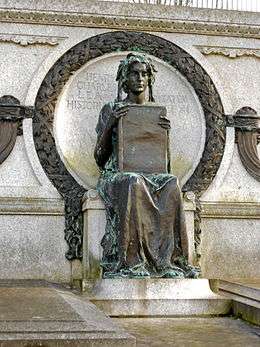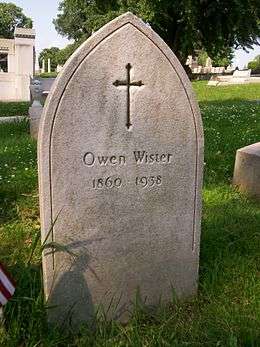Laurel Hill Cemetery
|
Laurel Hill Cemetery | |
|
William Warner memorial sculpted by Alexander Milne Calder | |
 | |
| Location | 3822 Ridge Avenue, Philadelphia, Pennsylvania |
|---|---|
| Coordinates | 40°00′14″N 75°11′15″W / 40.00389°N 75.18750°WCoordinates: 40°00′14″N 75°11′15″W / 40.00389°N 75.18750°W |
| Built | 1836-1839[1] |
| Architect | John Notman[1] |
| Architectural style | Exotic Revival, Gothic, Classical Revival |
| NRHP Reference # | 77001185[2] |
| Significant dates | |
| Added to NRHP | October 28, 1977 |
| Designated PHMC | May 20, 2000[3] |
Laurel Hill Cemetery is a cemetery in Philadelphia, Pennsylvania, that was the second major garden or rural cemetery in the United States. It was designated a National Historic Landmark in 1998, one of only a few cemeteries to receive the distinction.[4]
Located in Philadelphia's East Falls section, the 74-acre (300,000 m2) cemetery overlooks the Schuylkill River. Laurel Hill contains more than 33,000 monuments and more than 11,000 family lots. Its thousands of 19th- and 20th-century marble and granite funerary monuments include obelisks and elaborately sculpted hillside tombs and mausoleums.[5]
History
The cemetery was founded in 1836 by John Jay Smith, a librarian and editor with interests in horticulture and real estate who was distressed at the way his deceased daughter was interred in a Philadelphia churchyard. He and other prominent citizens decided to create a rural garden cemetery five miles north of Philadelphia, a location that was viewed as a haven from urban expansion and a respite from the increasingly industrialized city center. The property was acquired from businessman Joseph Sims.[1]
Designed by Scottish-American architect John Notman,[1] Laurel Hill introduced new landscape ideas and burial concepts and became a model for the rural cemetery movement. The cemetery was developed and completed between 1836 and 1839.[1] To increase its cachet, the cemetery's organizers had the remains of several famous Revolutionary War figures moved there, including Continental Congress secretary Charles Thomson; Declaration of Independence signer Thomas McKean; Philadelphia war veteran and shipbuilder Jehu Eyre; Hugh Mercer, hero of the Battle of Princeton; and David Rittenhouse, first director of the U.S. Mint.
During and after the American Civil War, Laurel Hill became the final resting place of hundreds of military figures, including 42 Civil War-era generals. Laurel Hill also became the favored burial place for many of Philadelphia's most prominent political and business figures, including Matthias W. Baldwin, founder of the Baldwin Locomotive Works; Henry Disston, owner of the largest saw factory in the world (the Disston Saw Works); and financier Peter A. B. Widener.
The city later grew past Laurel Hill, but the cemetery retained its rural character.
From its inception, Laurel Hill was intended as a civic institution designed for public use. In an era before public parks and museums, it was a multi-purpose cultural attraction where the general public could experience the art and refinement previously known only to the wealthy. Classical Revival, Gothic Revival, Egyptian Revival and other exotic styles are rendered in a wide palette of materials, including marble, granite, cast-iron and sandstone. Notable artists and architects, including Notman, Alexander Milne Calder and William Strickland contributed their designs. Laurel Hill became an immensely popular destination in its early years and required tickets for admission. Writer Andrew Jackson Downing reported “nearly 30,000 persons…entered the gates between April and December, 1848.”
In 1978, the Friends of Laurel Hill Cemetery, a 501(c)(3) non-profit organization, was founded to support the cemetery. The mission of the Friends is to assist the Laurel Hill Cemetery Company in preserving and promoting the historical character of Laurel Hill. The Friends raise funds and seek contributed services; prepare educational and research materials emphasizing the historical, architectural and cultural importance of Laurel Hill Cemetery; and provide tour guides to educate the public.
In the 21st century, two pairs of seats from Veterans Stadium were installed at the grave of Harry Kalas, the Frick Award-winning announcer for the Philadelphia Phillies, so they could be used by fans paying their respects.
Today, Laurel Hill Cemetery stands as a rich repository of both art and historical artifacts. Its monuments embody the rich design, craftsmanship and iconography of 19th and 20th century American funerary art, from simple obelisks to elaborate mausoleums.
Notable burials
_HABS314296cv.jpg)

Burials in the cemetery include:
- Robert Adams, Jr. (1849–1906), U.S. Congressman from Pennsylvania[7]
- Hilary Baker (1746–1798), mayor of Philadelphia[7]
- Matthias W. Baldwin (1795–1866), businessman, Baldwin Locomotive Works[7]
- Alexander Biddle (1819–1899), U.S. army officer[7]
- Robert Montgomery Bird (1803–1854), American novelist, playwright, and physician[7]
- David Bispham (1857–1921), opera singer[7]
- Charles E. Bohlen (1904–1974), U.S. diplomat[7]
- Henry Bohlen (1810–1862), Civil War Union Brigadier General[7]
- George Henry Boker (1823–1890), poet, playwright, and diplomat[7]
- Joseph Bonnell (1802–1840), West Point graduate, hero of the Texas Revolution
- Adolph E. Borie (1809–1880), Secretary of the Navy[7]
- Charles Brown (1797–1883), U.S. Congressman from Pennsylvania[7]
- John Cassin (1813–1869), ornithologist
- George William Childs (1829–1894), newspaper publisher[7]
- Walter Colton (1797–1851), Chaplain, Alcalde of Monterey, author, publisher of California's first newspaper
- David Conner (1792–1856), U.S. naval officer[7]
- Robert T. Conrad (1810–1858), mayor of Philadelphia[7]
- Joel Cook (1842–1910), U.S. Congressman from Pennsylvania[7]
- Robert Cornelius (1809–1893), pioneering photographer
- Martha Coston (1826–1904), inventor and businesswoman[7]
- Samuel W. Crawford (1829–1892), Union army general[7]
- Louisa Knapp Curtis (1851–1910), journalist and magazine publisher[7]
- John A. Dahlgren (1809–1870), U.S. naval officer[7]
- Richard Dale (1756–1826), Revolutionary naval officer[7]
- Henry Deringer (1786–1868), gunsmith[7]
- Henry Disston (1819–1878), businessman, Disston Saw Works[7]
- Ida Dixon (1854–1916), socialite and first female golf course architect in the United States[8]
- George Meade Easby (1918–2005), great-grandson of General George Meade and a celebrity figure
- George Nicholas Eckert (1802–1865), U.S. Congressman from Pennsylvania[7]
- Robert H. Foerderer (1860–1903), U.S. Congressman from Pennsylvania[7]
- Adam Forepaugh (1831–1890), an entrepreneur, businessman, and circus owner[7]
- Samuel Gibbs French (1818–1910), Confederate General[7] has a cenotaph in his family's plot in Laurel Hill.
- Frank Furness (1839–1912), Medal of Honor recipient, architect[7]
- Henry D. Gilpin (1801–1860), U.S. Attorney General[7]
- Louis Antoine Godey (1804–1878) American editor and publisher[7]
- Thomas Godfrey (1704–1749), optician and inventor[7]
- Frederick Gutekunst (1831-1917), prominent photographer
- Henry Schell Hagert (1826–1885), writer, poet, Philadelphia district attorney
- Sarah Josepha Hale (1788–1879), writer, poet[7]
- Frederick Halterman (1831–1907), U.S. Congressman[7]
- James Harper (1780–1873), U.S. Congressman[7]
- Ferdinand Rudolph Hassler (1770–1843), first superintendent of the United States Coast Survey[7]
- Joseph Hemphill (1770–1842), U.S. Congressman[7]
- Alexander Henry (1823–1883), Civil War mayor of Philadelphia
- Henry Wilson Hodge (1865–1919), engineer
- Isaac Hull (1773–1843), Commodore, USN, captained Constitution to victory over HMS Guerriere[7]
- Owen Jones (1819–1878), U.S. Congressman[7]
- Harry Kalas (1936–2009), Philadelphia Phillies Hall of Fame broadcaster[7]
- Elisha Kane (1820–1857), explorer
- William D. Kelley (1814–1890), U.S. Congressman[7]
- William J. Kirkpatrick (1838–1921), composer
- Henry Charles Lea (1825–1909), historian
- Michael Leib (1760–1822), U.S. Congressman[7]
- Lewis Charles Levin (1808–1860), U.S. Congressman[7]
- George Horace Lorimer (1868–1937), journalist[7]
- Thomas McKean (1734–1817), lawyer and politician, Signer of the Declaration of Independence[7]
- George Gordon Meade (1815–1872), Union General, victor at the Battle of Gettysburg[7]
- Hugh Mercer (1726–1777), Continental general in the American Revolution[7]
- Helen Abbott Michael (1857–1904), plant chemist
- William Millward (1822–1871), U.S. Congressman[7]
- John Moffet (1831–1884), U.S. Congressman[7]
- Edward Joy Morris (1815–1881), U.S. Congressman[7]
- Charles Naylor (1806–1872), U.S. Congressman[7]
- John Notman (1810–1865), architect and designer of Laurel Hill
- Francis E. Patterson (1821–1862), Union general in the Civil War
- Titian Peale (1799–1885), artist[7]
- John C. Pemberton (1814–1881), Confederate Civil War General[7]
- Garrett J. Pendergrast (1802–1862), U.S. Civil War naval officer[7]
- Boies Penrose (1860–1921), U.S. Senator[7]
- Samuel J. Randall (1828–1890), U.S. Congressman[7]
- Thomas Buchanan Read (1822–1872), American poet, sculptor, portrait-painter[7]
- Joseph Reed (1741–1785), Continental Congressman
- John E. Reyburn (1845–1914), U.S. Congressman, mayor of Philadelphia[7]
- William S. Reyburn (1882–1946), U.S. Congressman[7]
- David Rittenhouse (1732–1796), astronomer, inventor, mathematician, surveyor[7]
- John Robbins (1808–1880), U.S. Congressman[7]
- Richard Rush (1780–1859), U.S. Attorney General[7]
- Lawrence Saint (1885–1961), stained glass artist
- Jonathan Sergeant (1746–1793), Continental Congressman[7]
- Charles Ferguson Smith (1807–1862), U.S. Army General[7]
- Witmer Stone (1866–1939), ornithologist, botanist
- Thomas Sully (1783–1872), portrait painter[7]
- Charles Thomson (1729–1824), secretary of the Continental Congress[7]
- George Washington Toland (1796–1869), U.S. Congressman[7]
- Levi Twiggs (1793–1847), officer in the U. S. Marine Corps[7]
- Job Roberts Tyson (1803–1858), U.S. Congressman[7]
- Richard Vaux (1816–1895), U.S. Congressman, mayor of Philadelphia[7]
- Thomas Ustick Walter (1804–1887), architect[7]
- Jonathan Williams (1751–1815), U.S. Army officer and first superintendent of West Point
- Peter A. B. Widener (1834–1915), business tycoon, philanthropist[7]
- Isaac J. Wistar (1827–1905), Union Army general and penologist[9]
- Owen Wister (1860–1938), novelist, author of The Virginian[7]
- Jacob Zeilin (1806–1880), 7th Commandant of the U.S. Marine Corps, Marine Corps' first general officer[7]
Fictional references
- The young adult book Tombstone Tea[10] by Joanne Dahme takes place in Laurel Hill Cemetery and some of the well-known people buried there appear as characters.
- A headstone marks the grave of the fictional Adrian Balboa. It was used as a prop in the 2006 motion picture Rocky Balboa which was filmed at the cemetery.[11]
See also
Notes
- 1 2 3 4 5 "General View of Laurel Hill Cemetery". The Library Company of Philadelphia. World Digital Library. Retrieved 5 January 2014.
- ↑ National Park Service (2007-01-23). "National Register Information System". National Register of Historic Places. National Park Service.
- ↑ "PHMC Historical Markers". Historical Marker Database. Pennsylvania Historical & Museum Commission. Retrieved December 10, 2013.
- ↑ Listing at the National Park Service
- ↑ National Historic Landmark Nomination, Aaron V. Wunsch, National Park Service, 1998.
- ↑ Mullen Tomb December 26, 1881 article from the New York Times.
- 1 2 3 4 5 6 7 8 9 10 11 12 13 14 15 16 17 18 19 20 21 22 23 24 25 26 27 28 29 30 31 32 33 34 35 36 37 38 39 40 41 42 43 44 45 46 47 48 49 50 51 52 53 54 55 56 57 58 59 60 61 62 63 64 65 66 67 68 69 70 71 72 Laurel Hill Cemetery at Find-A-Grave
- ↑ "The Historic Buildings of the Community Arts Center in Wallingford, Pennsylvania" (PDF). Community ArtsCenter.org. Retrieved 30 November 2015.
- ↑ Warner, Ezra J., p. 569 Missing or empty
|title=(help) - ↑ Tombstone Tea Amazon listing Amazon.com. Retrieved 5 October 2009.
- ↑ Why does Rocky’s wife get a tombstone at Laurel Hill?, by Dotun Akintoye , 18 July 2013, Philadelphia City Paper
References
- Warner, Ezra J. (1964). Generals in Blue: The Lives of the Union Commanders. Louisiana State University Press. ISBN 0-8071-0822-7.
External links
| Wikimedia Commons has media related to Laurel Hill Cemetery. |
- Official website
- Historic American Buildings Survey, Laurel Hill Cemetery, HABS No. PA-1811 (Adobe .pdf format)
- Our Burial Lot (Kennedy), North Laurel Hill Cemetery, June 14, 1875 by D.J. Kennedy, Historical Society of Pennsylvania
- Laurel Hill Cemetery sculptures, Association for Public Art website
- From the collection of The Library Company of Philadelphia:



